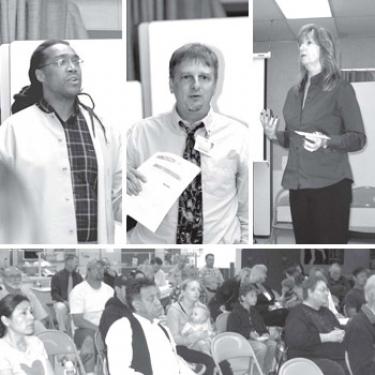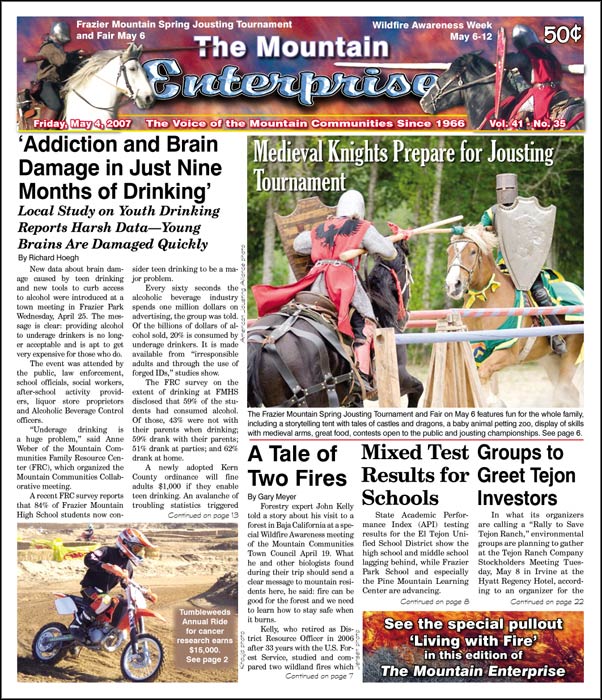
Above (l-r) Michael Browning, Chris Reilly and Anne Weber. Below, the community turned out to learn about local research.
Local Study on Youth Drinking Reports Harsh Data—Young Brains Are Damaged Quickly
By Richard Hoegh
New data about brain damage caused by teen drinking and new tools to curb access to alcohol were introduced at a town meeting in Frazier Park Wednesday, April 25. The message is clear: providing alcohol to underage drinkers is no longer acceptable and is apt to get very expensive for those who do.
The event was attended by the public, law enforcement, school officials, social workers, after-school activity providers, liquor store proprietors and Alcoholic Beverage Control officers.
"Underage drinking is a huge problem," said Anne Weber of the Mountain Communities Family Resource Center (FRC), which organized the Mountain Communities Collaborative meeting.
A recent FRC survey reports that 84% of Frazier Mountain High School students now consider teen drinking to be a major problem.
Every sixty seconds the alcoholic beverage industry spends one million dollars on advertising, the group was told. Of the billions of dollars of alcohol sold, 20% is consumed by underage drinkers. It is made available from "irresponsible adults and through the use of forged IDs," studies show.
The FRC survey on the extent of drinking at FMHS disclosed that 59% of the students had consumed alcohol. Of those, 43% were not with their parents when drinking; 59% drank with their parents; 51% drank at parties; and 62% drank at home.
A newly adopted Kern County ordinance will fine adults $1,000 if they enable teen drinking. An avalanche of troubling statistics triggered this measure.
New clinical data confirms that teen drinking suppresses brain development. Teenage drunks carry a heavy responsibility for fatal car crashes in this county. Teen crime and unwanted teen pregnancies are linked to drinking, which also impacts school attendance and schoolwork.
Because of the developmental changes taking place in the brain and endocrine system during the teen years, the teen drinker is on-track to becoming a physiologically addicted alcoholic within nine months of the first drink, studies now confirm.
Weber proposes to work with parents, community residents and students in a program modeled on California’s successful attack on tobacco use.
Sergeant Dave Barker of Kern County Sheriff’s Department explained the new ordinance. Parents who supply alcohol to underage drinkers are subject to the $1,000 fine.
"For the ordinances to be effective, violations must be called in," agreed Sr. Deputy Clark and Deputy Triplett of the Ventura County Sheriff’s Office, which serves Lockwood Valley. A similar ordinance has been adopted by Ventura County.
Alberto Gonzalez, District Supervisor with Alcohol Beverage Control, said he hires decoys—people 17 to 18 years old—who attempt to buy alcoholic beverages from retailers. In Kern County, his decoys score a "hit" about 10% of the time. The licensee found guilty of selling to an underage drinker is subject to a fine up to $25,000.
Frazier Mountain High School Principal Dan Penner emphasized that students from sixth grade on need help to deal with the availability of alcohol. Penner suggested schools set a ‘zero-tolerance’ policy, prohibit alcohol use by participants in sports, provide security on the campus, monitor campus activities with drug-sniffing dogs and check campus activities through the use of cameras.
He said schools can provide information through publications, posters and through discussions on drinking.
Chris Reilly, Director of Behavioral Health at Clinica Sierra Vista Mental Health Centers, referred to alcohol as a ‘gateway’ drug that leads to use of dead end drugs such as methamphetamine.
Lily Alvarez, Alcohol and Drug Administrator for Kern County’s Behavioral Health Administration explained that alcohol retards brain development. Its impact on the stilldeveloping brain also results in the surprising speed with which teen drinkers become alcoholics— often within nine-months.
"Alcohol shuts down brain development and social development that normally occur at that age," Alvarez said.
In this reporter’s experience, which includes 31 years in Alcoholics Anonymous (AA), I have frequently heard the comment that newcomers "arrive in their high-chairs," having become addicted at an early age, which arrests development in critical ways.
Michael Browning, Regional Trainer at the Institute for the Study of Social Change, University of California Berkeley, is working with Kern County communities to organize after school activities. He is coming to Frazier Park to consult in May.
Beth Villanueva, President of the Frazier Mountain chapter of the American Youth Soccer Organization said AYSO is seeking sign ups now for the fall season. "This is a good example of structured alcohol-free and drug-free fun," she said, adding, "AYSO events are a ‘no alcohol allowed,’ atmosphere."
Alcoholics Anonymous teaches that those involved with alcohol who wish to quit must make the decision for himself or herself alone. Considering the benefits of quitting and the destructive consequences of not quitting, it should be an easy decision.
This is part of the May 04, 2007 online edition of The Mountain Enterprise.
Have an opinion on this matter? We'd like to hear from you.


